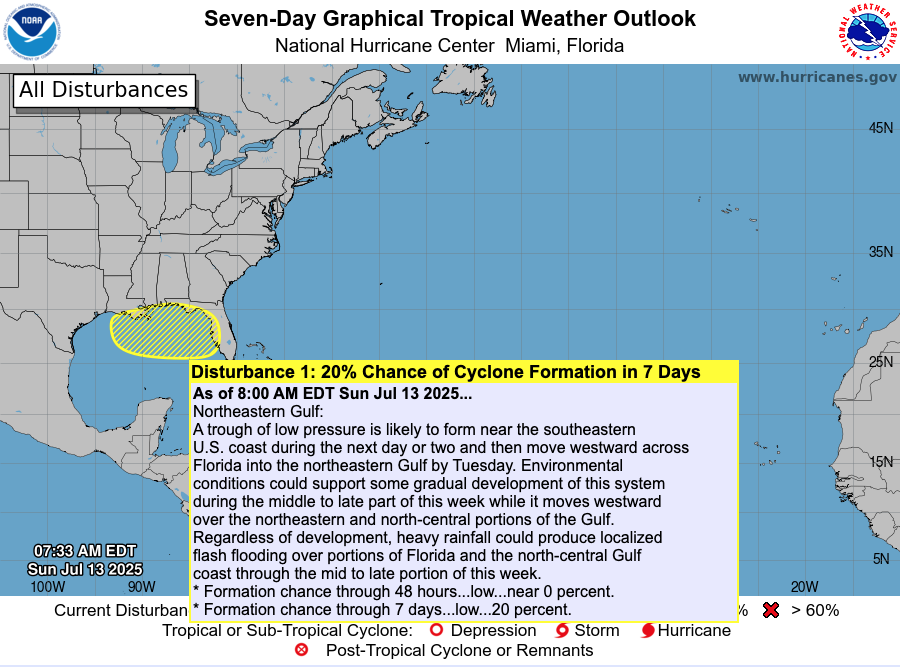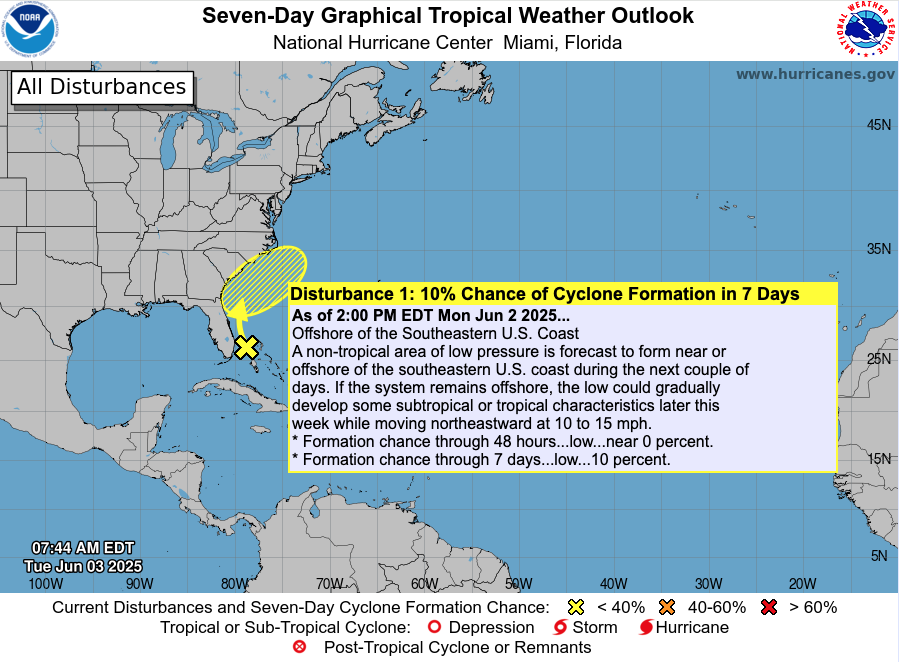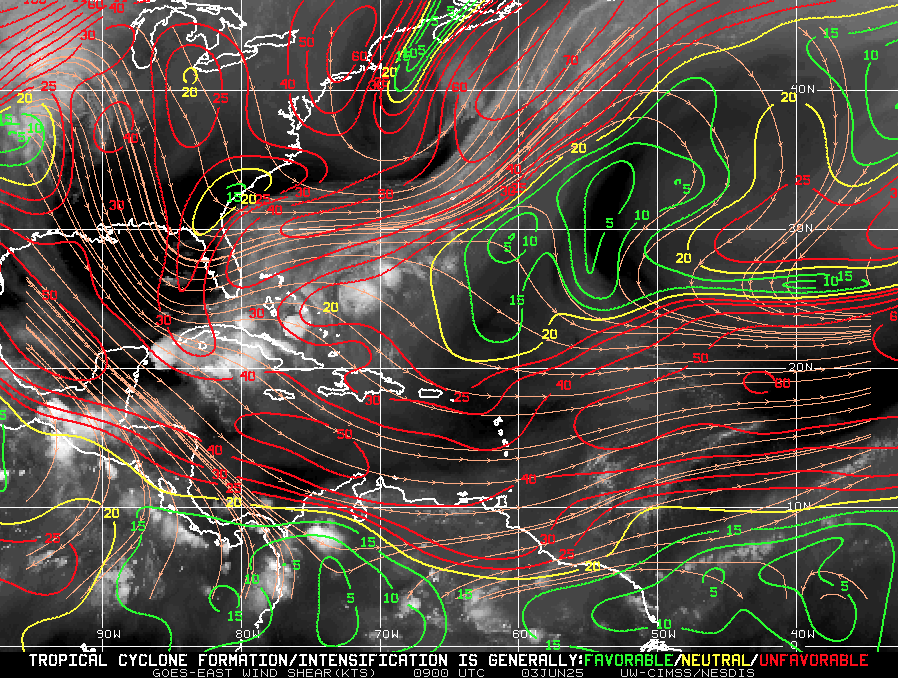Atlantic Hurricane Outlook – July 13, 2025: Tropics Quiet, Gulf Trough Under Watch
No named storms today, but a low-pressure trough drifting toward the Gulf of Mexico could bring rain and potential tropical development later this week.
The Atlantic basin remains calm today, with no active named storms. However, meteorologists are tracking a low-pressure trough emerging off the Southeast U.S. coast, gradually drifting into the Gulf of Mexico. This system has a low (20%) chance of organizing into a subtropical or tropical system later this week .
Atlantic Overview: Quiet But Evolving
As per the 8 AM EDT NHC Tropical Weather Outlook:
No active tropical cyclones across the basin.
The Southeast U.S. trough is expected to push into the Gulf by Tuesday.
Formation chances: <1% in next 48 hours, ~20% over 7 days .
Though not tropical now, its movement may increase rainfall and raise attention if organization begins.
Satellite view via Windy.com
Sea Surface Temperatures: A Warm Platform
The Gulf of Mexico continues to show SSTs 2–4°F above average, providing a warm environment for storm development later this season.
Caribbean and Main Development Region (MDR) SSTs also remain elevated, keeping hurricane fuel accessible .
Sea Surface Temperature via Windy.com
Atmospheric Setup: Suppression in Play
Wind Shear Courtesy of https://tropic.ssec.wisc.edu/
Wind shear remains moderately strong across much of the basin, hindering storm development.
Saharan dust is still prevailing over the eastern Atlantic, suppressing early-season storm growth.
Moisture levels are slowly increasing in the Gulf and Southeast U.S., signaling gradual support for convection.
Saharan Air Layer (Dust) via Windy.com
Regional Weather: Rain on the Rise
Expect increased showers and thunderstorms along the Southeast U.S. and Gulf coasts as the trough approaches.
Florida will likely see scattered afternoon storms, typical for July, especially as the trough draws moisture inland.
Thunderstorm Forecast (ECMWF) via Windy.com
Prep Tip of the Day: Be Rainwise
Even without strong winds, heavy rainfall can pose serious hazards:
Track the trough’s movement—it could bring localized flash flooding to Gulf coast areas.
Ensure storm drains and sump pumps are clear and functional.
Keep sandbags and quick barriers ready if you're in low-lying zones.
Test your NOAA Weather Radio and mobile alerts to stay ahead of rainfall warnings.
Looking Ahead: Waters Stay Warm—Storms Could Spark
Although the tropics are peaceful now, the combination of warm ocean temperatures, easing atmospheric inhibitors, and growing seasonal moisture suggest readiness for evolution. The trough may serve as the first spark of Gulf activity, with a watchful eye needed through mid- to late-week.
Stay alert and check back tomorrow for your latest update from Cat5Prep.com.
Atlantic Hurricane Outlook – June 13, 2025: Record-Warm Waters, Calm Tropics
The Atlantic remains calm on June 13, 2025, with no tropical systems expected this week. But record-warm ocean temperatures hint at growing potential for storms later in June.
As of this morning, the Atlantic basin remains quiet with no active tropical cyclones, and the National Hurricane Center (NHC) is not monitoring any areas for development over the next seven days. This early season calm is typical for June, but it's occurring alongside some of the warmest sea surface temperatures (SSTs) on record for this time of year.
Atlantic Basin: No Immediate Threats
There are no named storms, no tropical disturbances, and no development expected through June 20, according to the NHC’s latest outlook. While quiet conditions aren’t unusual for early June, the current oceanic heat buildup is setting the stage for a potentially more active second half of the month.
Satellite data via Windy.com
Sea Surface Temperatures: Running Hot
Across much of the Atlantic basin:
Gulf of America (Mexico): SSTs are in the low to mid-80s°F (28–30°C), well above average
Western Caribbean: Also warm, supporting favorable conditions for future development
Main Development Region (MDR): Temperatures continue to trend higher than normal — a red flag as we move closer to peak hurricane season
SST data via Windy.com
Atmospheric Conditions: Mixed Signals
Wind Shear: Remains moderate to high in some areas, limiting storm organization for now, but models show signs of gradual easing
Saharan Air Layer (SAL): Dry, dusty air continues to spread across the eastern and central Atlantic, suppressing convection
Moisture Levels: Slowly increasing in the western Caribbean and Gulf, signaling that the environment is gradually becoming more storm-friendly
Wind Shear Courtesy of https://tropic.ssec.wisc.edu/
Thunderstorm Activity: Diurnal, Not Tropical
Florida and the Southeast U.S.: Expect typical scattered afternoon thunderstorms, driven by heating — not tropical systems
Caribbean and Atlantic: No signs of organized storm activity
Thunderstorm data via Windy.com
Florida Forecast: Midsummer Preview
Highs: Upper 80s to low 90s°F (31–33°C)
Humidity: High — muggy conditions will persist
Rain: Afternoon storms likely in areas, but short-lived and localized
Winds: Light and variable
Thunderstorm data via Windy.com
Prep Tip of the Day: Know What to Watch For
Now’s a great time to sharpen your hurricane awareness:
Follow daily updates from Cat5Prep and the National Hurricane Center
Brush up on storm formation basics — including the roles of sea surface temperatures, wind shear, and the Saharan Air Layer
Update your hurricane supplies and family communication plan
Looking Ahead: Stay Ready
While the tropics are quiet now, conditions are steadily shifting. Record-breaking ocean heat, reducing wind shear, and a moistening atmosphere all point toward a potentially active late June and July. The calm won’t last forever — use this time to prepare.
Stay safe. Stay informed. Stay ready with Cat5Prep.com.
Atlantic Hurricane Outlook – June 3, 2025: Conditions Ripening Beneath the Calm
The 2025 Atlantic hurricane season starts quietly, but today, June 3, 2025, the National Hurricane Center identifies a new low-pressure area off the Southeastern U.S. coast. Conditions are slowly becoming more favorable for storm development this week.
The third day of the 2025 Atlantic hurricane season begins much like the last—quiet skies and no named systems. But meteorologists are watching closely. While there are no storms on the map, the ingredients for tropical cyclone formation are slowly assembling. Sea surface temperatures are rising, atmospheric inhibitors are weakening, and thunderstorm activity is beginning to build in key regions. It’s still early—but don’t get too comfortable.
Atlantic Basin: New Area of Interest and Overall Quiet
As of yesterday afternoon’s update from the National Hurricane Center (NHC), a new area of low pressure has been identified just off the southeastern United States coast:
A non-tropical area of low pressure is expected to form near or offshore of the southeastern U.S. coast in the next couple of days.
If it remains offshore, it could gradually acquire subtropical or tropical characteristics later this week while tracking northeastward at 10 to 15 mph.
Formation chance through 48 hours: Low (near 0%)
Formation chance through 7 days: Low (10%)
While development is currently unlikely, this is the first flagged area of interest in the Atlantic this season — a reminder that conditions are slowly trending more favorable. Models will continue to be monitored for any shifts in track or intensity.
At this time, no direct impacts are expected for the U.S. mainland, but boaters and beachgoers along the Southeast Coast should monitor local marine conditions later this week.
Otherwise, the basin remains quiet:
No active tropical cyclones
No other areas of interest
No tropical development expected in the next 7 days
A quiet start like this is typical for early June but it’s not a signal to let your guard down. The long-range outlook hints at increasing activity potential by mid-to-late June, especially in the western Caribbean and Gulf of America (Mexico).
Satellite imagery courtesy of Windy.com
Sea Surface Temperatures: Storm Fuel Is Already in Place
Warm waters are the engine that powers hurricanes, and the Atlantic is already running hot:
Gulf of America (Mexico): 2–4°F above average, with widespread 86°F+ (30°C) readings
Western Caribbean: Elevated SSTs continue to build near Central America and Cuba
Main Development Region (MDR): Trending warmer than normal, with the potential to support long-track storms later this season
These above-average temperatures are primed to support rapid intensification once storm systems begin to form.
Sea surface temperature data courtesy of Windy.com
Wind Shear & Moisture: A Shifting Balance
Wind shear—the atmospheric force that disrupts hurricane development—is weakening, especially in the Caribbean and Gulf. At the same time, moisture levels in the lower and mid-atmosphere are rising.
This combination supports stronger thunderstorms and vertical cloud development—key precursors for tropical formation.
Wind-shear Map Image Courtesy of : https://tropic.ssec.wisc.edu/
Saharan Air Layer: Dust Is Holding Steady—for Now
A broad stretch of the Saharan Air Layer (SAL) is still active across the central and eastern Atlantic:
Dry, stable air disrupts tropical wave development
Increased wind shear limits vertical convection
Dust particles reduce storm cloud organization
While the SAL continues to offer some protection in the eastern Atlantic, it’s expected to weaken later this month—removing one of the last early-season barriers to storm growth.
Satellite dust data courtesy of Windy.com
Thunderstorm Activity: Not Just Summer Weather
While today’s thunderstorms aren’t tropical, their growing presence is important:
Western Caribbean: Clusters of convection are forming, though currently disorganized
Southeastern U.S. & Gulf Coast: Expect afternoon storms, fueled by heat and humidity
These storm systems help prime the atmosphere for eventual tropical development and are often the earliest signs of areas of interest.
Thunderstorm data courtesy of Windy.com
Florida Forecast: A Classic, Stormy Summer Day
Expect another typical early June day across the Sunshine State:
North Florida: Upper 80s, low humidity, mostly clear
Central Florida: Around 90°F with building humidity and scattered PM storms
South Florida: Mid-80s, muggy, with increased chances of storms after 2 PM
Though today’s storms are not tropical, the overall pattern is signaling a slow seasonal transition.
Forecast radar imagery courtesy of Windy.com
Prep Tip of the Day: Get Ahead While It’s Quiet
This calm window is the perfect time to prepare:
Review your hurricane plan and local evacuation routes
Restock your hurricane kit—especially water, batteries, and medications
Take photos of your home and valuables for insurance
Sign up for local emergency alerts and bookmark Cat5Prep.com
Know the difference between a watch and a warning before one is issued
Looking Ahead: No Storms Now, But Don’t Let That Fool You
Though nothing is spinning in the Atlantic today, all signs point to rising potential in the weeks ahead. Sea temperatures are already warm enough to support hurricanes. Wind shear is fading. Moisture and thunderstorm activity are increasing.
We are not forecasting imminent development—but the environment is evolving fast.
Check back tomorrow for your daily hurricane update from Cat5Prep.com.







